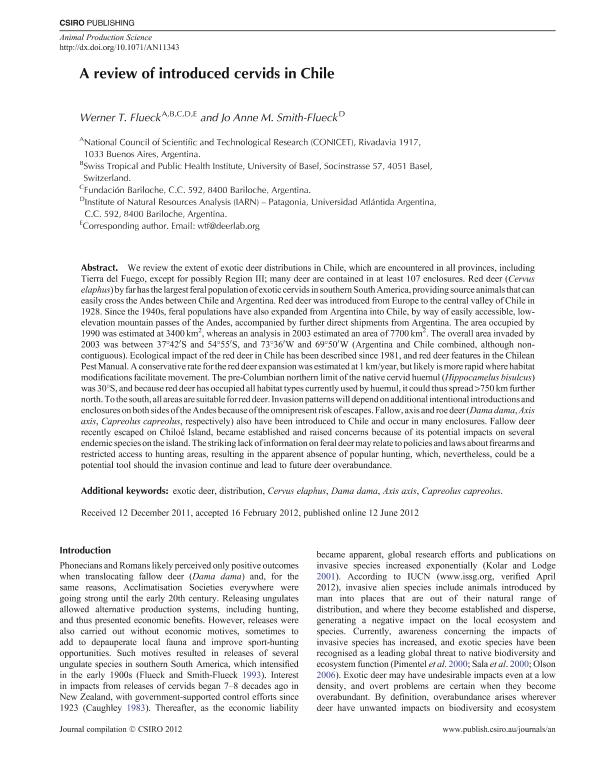Mostrar el registro sencillo del ítem
dc.contributor.author
Fluck, Werner Thomas

dc.contributor.author
Smith-Flueck, Jo Anne M.
dc.date.available
2023-05-03T19:43:27Z
dc.date.issued
2012-06
dc.identifier.citation
Fluck, Werner Thomas; Smith-Flueck, Jo Anne M.; A review of introduced cervids in Chile; Csiro Publishing; Animal Production Science; 52; 8; 6-2012; 681-684
dc.identifier.issn
1836-0939
dc.identifier.uri
http://hdl.handle.net/11336/196174
dc.description.abstract
We review the extent of exotic deer distributions in Chile, which are encountered in all provinces, including Tierra del Fuego, except for possibly Region III; many deer are contained in at least 107 enclosures. Red deer (Cervus elaphus) by far has the largest feral population of exotic cervids in southern South America, providing source animals that can easily cross the Andes between Chile and Argentina. Red deer was introduced from Europe to the central valley of Chile in 1928. Since the 1940s, feral populations have also expanded from Argentina into Chile, by way of easily accessible, low-elevation mountain passes of the Andes, accompanied by further direct shipments from Argentina. The area occupied by 1990 was estimated at 3400km2, whereas an analysis in 2003 estimated an area of 7700km2. The overall area invaded by 2003 was between 3742'S and 5455'S, and 7336'W and 6950'W (Argentina and Chile combined, although non-contiguous). Ecological impact of the red deer in Chile has been described since 1981, and red deer features in the Chilean Pest Manual. A conservative rate for the red deer expansion was estimated at 1km/year, but likely is more rapid where habitat modifications facilitate movement. The pre-Columbian northern limit of the native cervid huemul (Hippocamelus bisulcus) was 30S, and because red deer has occupied all habitat types currently used by huemul, it could thus spread 750km further north. To the south, all areas are suitable for red deer. Invasion patterns will depend on additional intentional introductions and enclosures on both sides of the Andes because of the omnipresent risk of escapes. Fallow, axis and roe deer (Dama dama, Axis axis, Capreolus capreolus, respectively) also have been introduced to Chile and occur in many enclosures. Fallow deer recently escaped on Chiló Island, became established and raised concerns because of its potential impacts on several endemic species on the island. The striking lack of information on feral deer may relate to policies and laws about firearms and restricted access to hunting areas, resulting in the apparent absence of popular hunting, which, nevertheless, could be a potential tool should the invasion continue and lead to future deer overabundance.
dc.format
application/pdf
dc.language.iso
eng
dc.publisher
Csiro Publishing

dc.rights
info:eu-repo/semantics/openAccess
dc.rights.uri
https://creativecommons.org/licenses/by-nc-sa/2.5/ar/
dc.subject
AXIS AXIS
dc.subject
CAPREOLUS CAPREOLUS.
dc.subject
CERVUS ELAPHUS
dc.subject
DAMA DAMA
dc.subject
DISTRIBUTION
dc.subject
EXOTIC DEER
dc.subject.classification
Ecología

dc.subject.classification
Ciencias Biológicas

dc.subject.classification
CIENCIAS NATURALES Y EXACTAS

dc.title
A review of introduced cervids in Chile
dc.type
info:eu-repo/semantics/article
dc.type
info:ar-repo/semantics/artículo
dc.type
info:eu-repo/semantics/publishedVersion
dc.date.updated
2023-05-03T15:47:12Z
dc.journal.volume
52
dc.journal.number
8
dc.journal.pagination
681-684
dc.journal.pais
Australia

dc.description.fil
Fil: Fluck, Werner Thomas. Universidad Atlantida Argentina; Argentina. Fundación Bariloche; Argentina. Consejo Nacional de Investigaciones Científicas y Técnicas; Argentina
dc.description.fil
Fil: Smith-Flueck, Jo Anne M.. Universidad Atlantida Argentina; Argentina
dc.journal.title
Animal Production Science

dc.relation.alternativeid
info:eu-repo/semantics/altIdentifier/url/https://www.publish.csiro.au/an/AN11343
dc.relation.alternativeid
info:eu-repo/semantics/altIdentifier/doi/http://dx.doi.org/10.1071/AN11343
Archivos asociados
